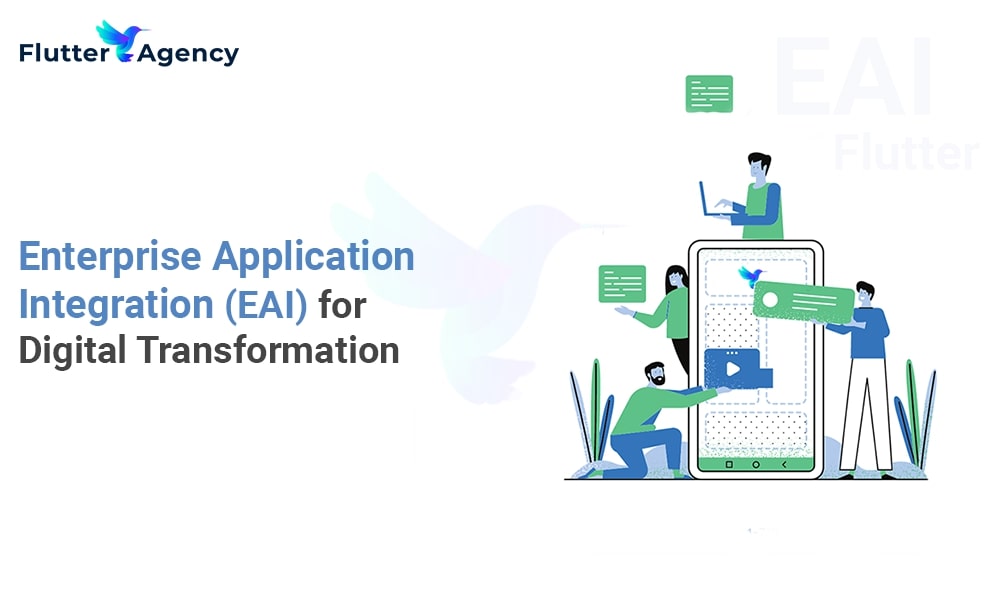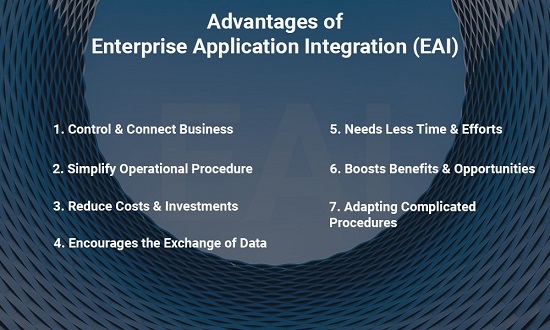Enterprise Application Integration with Digital Transformation in Business
Different software and applications are necessary for successful businesses. However, managing them across platforms would take significant work, money, and time. The fundamental idea behind application integration strategies was this. Many businesses are starting to use them, mainly looking for creative ways to use them properly.
To implement application modernization, cloud computing, or business process modernization, enterprise application integration (EAI) is essential for driving transformation. It is mainly driven by the need to enable the mobile workforce and realize organizational objectives for optimizing internet and e-commerce usage. It gives the business better and more control through speedier production, time and effort reductions, data storage and protection, and more.
This article’ll explain the idea, strategy, how it operates, best practices, how it would benefit your business, and much more.
Overview of Application Integration
In simple terms, it involves sharing crucial business processes and data across an organization. It allows various applications to consolidate and share data, resources, and processes. This enables you to easily integrate different on-premises and cloud-based applications to transform and use data for successful operations.
EAI, meanwhile, is the process of integrating enterprise apps with the support of IT-enabled devices. It is over a common platform and calls for data integration at the back end to ensure that connected apps run smoothly. Additionally, EAI improves data availability while streamlining billing, marketing, accounting, and customer relationship management procedures. It helps establish a middleware framework that permits unrestricted data flow across applications without significantly changing the database configurations or the apps themselves. What are the benefits of ROI-led strategies? Read our blog to learn why investing in application integration is essential and how we can assist enterprises like yours to develop robust standalone solutions.
Enterprise Application Integration Benefits
Consider every application that your business use. Consider the ones that demand integration right now. Data is transformed by modern integration connectors to make it compatible with IT architecture and to speed up procedures. Additionally, small to large businesses are putting more attention on integrating their apps in this highly competitive industry.
Do you want to know how EAI technology can simplify your significant worries? If you want a thorough understanding of the business advantages of EAI, read this.
1. Control and connect your business
To have total control over your business, use the enterprise application integration. This is because information management is enhanced since it provides a comprehensive view and, through its various methods, enables a complete understanding of everything that takes place.
The entire network of connections, ranging from software information to employee-related factors, can be handled and controlled when you run a business or occupy a higher position.
2. It simplifies operational procedures
The streamlining and simplification of all company processes is one area in which EAI technologies thrive. It makes no difference if the IT framework is complicated or if there are numerous asynchronous apps.
3. Reduces costs and investments
The deployment of EAI technologies greatly aids the lowering of costs inside the organization. Combining old and new software is an obvious example; fewer investments exist since the former does not need to be deleted.
Additionally, it is possible to develop new services and products that can be used internally and externally because of the integration of business enterprise applications. This will ultimately help you preserve money at all costs.
4. It encourages the exchange of information
Information communication is significantly increased when a company’s various components and its individual IT infrastructures and applications are connected.
Access to the company’s data and software is available to all employees. Due to decreased information duplication, the structure functions better and is significantly more effective.
6. It requires less time and effort
All organizational data can be gathered together by integrating several software systems, greatly simplifying the work of every employeeActivities can be finished with less time and effort as a result.
Large-scale projects frequently take a long time to accomplish, however EAI has made this process faster. As a result, the company works at its best and eliminates redundant tasks. Production at the company has increased, and it is much easier to streamline and monitor business issues.
7. Increased benefits and opportunities
It is feasible to improve competitive advantages and opportunities compared to the various businesses acting as competition thanks to the implementation of EAI technologies.
Business integration is crucial in helping those that use it gain the lead. A company’s productivity drops when it has a weak IT structure, which could lead to significant losses.
But when EAI technologies are used, problem-solving abilities are enhanced, and output is significantly raised and more efficient. Even a competitive edge is implied. Its management can be improved in areas like marketing, ultimately increasing your company’s visibility in the business community.
8. Adapting to complex procedures
The execution of various business procedures is also included in the business scope. It is much simpler to track and analyze them with EAI to comprehend how they function and manage them. It offers a range of analysis methods to assist in monitoring every business function.
In short, EAI technologies can adapt to any process, which means they can always support the business’s analysis and monitoring.
Currently, enterprise software development is one of the most effective methods to run any business and boost efficiency. Utilizing technologies across the complete business process is crucial because they help in adaptability and the seemingly relentless advancement of technology.
EAI technology has aided businesses in expanding. Applications, software integration, and the monitoring of corporate activities are very beneficial in many ways. It is crucial to take them into account because of EAI.
Strategy for Application Integration
We’ll cover all you need to know about how these strategies can help you and how your strategy is just as crucial.
1. Data Integration in Batch
EAI assists in synchronizing all databases, enabling total data access throughout a business, regardless of whether applications are utilized for internal or externally exposed software. Here, the integration process is started by an application reading data from another app or part of the software. When transferring data, a relationship between several different factors, including file format, location, standards, privileges, and more, must be established beforehand between each other.
2. Invoking Remote Procedures
This takes place when an application offers a feature through an interface that serves as a layer to manage complex datasets. Other applications can use it if it has a clear and robust interface.
3. SOA/ESB
Organizations most frequently choose the ESB infrastructure and the architectural model provided by SOA technology for integration.
4. Shared Database
Most businesses have individual databases that assist teams with everyday tasks. There is a danger that information will be stored redundantly and in duplicate because so many people have access to it. With the proper application integration strategy, you may consolidate all the data into a single, reusable repository while preventing information duplication and development.
5. Messaging Strategies
A messaging integration approach maintains communication across multiple organizational apps using a message bus. The bus facilitates the transfer of information, tasks, and data, resulting in a seamless flow of communication.
5 Enterprise Application Integration Models
Numerous approaches aid in connecting multiple apps because there is no one-size-fits-all strategy for integration. However, the following five EAI types are ones with which we can assist you:
1. Integration from point to point
- It manages simple interactions between two data sources.
- A script extracts, translates, and transfers data from one application to another as part of this strategy.
- It proved efficient while handling a few systems at once and ineffective when operating relatively minor methods.
2. Integration Using Hub-and-Spoke
- As its name implies, this concept utilizes a central “hub” where systems and applications communicate via “spokes.”
- Since the data is reorganized and delivered from a single central database, connecting various subsystems is unnecessary.
- The development team would nevertheless need to use components that would automatically set the route information to the relevant destination.
3. Integration of Bus
It does the same duties as the hub-and-spoke model but in a different architecture.
Using an established set of standards that control data flow across apps, it operates independently.
It makes data transmission and retrieval possible according to each service’s rules and regulations.
4. Middleware
This software works with application interfaces and operating systems to translate and permit communication. Data aggregation across systems utilizing various scripts and formats is more straightforward with the middleware technique.
5. Microservices
The standardized architecture for modern cloud-based enterprise applications is included in microservices. Application programming interfaces (APIs) enable businesses using web-based integration to get massive data from internal and external sources.
Best Tools for Enterprise Application Integration
We want to assist you in selecting the best application integration tool for your business out of the numerous options offered in the market. Here are a few to think about:
1. WebSphere MQSeries by IBM
It aids in the integration of external and backend systems into your applications. Using this tool, you can access an array of APIs and use your hardware and software assets without having to write any complicated code.
2. Oracle Fusion
Even when your data is scattered across several locations, this method aids in connecting the appropriate users to your applications. It aids in developing, monitoring, and portability-optimized optimization of processes over time.
3. Workato
This tool assists in integrating your applications, whether hosted locally or in the cloud. Using a combination of actions, triggers, and apps, you may automate workflows that integrate applications with user-created tasks.
4. BizTalk
This tool assists your company in designing, developing, and deploying a variety of apps while automating and optimizing business operations.
5. Cloud Elements
It offers an API connection package with pre-built connectors known as Elements and is one of the best enterprise application integration tools available. Thus, these components enable connections with various cloud service endpoints to offer event-based workflows, standard authentication, search & discovery APIs, and unified error management.
Challenges with Enterprise application integration
You may run across the following challenges while working along with enterprise application integration:
Increased risks to security. Data is better protected when it is stored in distinct databases. Integration creates vulnerabilities since it makes it simpler for trustworthy people and detrimental intruders to access data. As a result, multi-factor authentication and other robust data access control mechanisms are advocated for use by businesses. To limit damage in the case of a breach, businesses implementing EAI projects also need to pay attention to network security and have an incident response plan in place.
Integration of legacy systems. Using proprietary protocols and particular data formats by legacy systems makes sharing data with modern apps challenging. Additionally, the data they produce may need to be completed or compatible with data from other apps. Businesses can design their unique APIs or use integration middleware to simplify data interchange to connect to more modern systems.
Scalability. You should include more applications and systems as your company grows. The integration system should be able to handle any workload spikes that may occur as these data sources expand. The scalability challenge can be approached in a variety of ways:
- Choose cloud-based EAI tools that can scale as needed.
- To distribute an increasing burden among several servers, use load balancing.
- Start by designing your EAI solution with scalability in mind.
A governance framework is required. Integrating enterprise applications will likely involve several teams and even departments. Each of these individuals will possess a unique set of skills and work methods. Companies must create guidelines and rules to ensure everyone follows the same path. This comprises the following four aspects but is not limited to them:
Create a plan for managing change. Employees will be guided by and shown how to manage EAI-related challenges with minimum work disturbance using this technique.
Assign responsibilities and roles. To manage expectations, distribute EAI-related tasks across the teams involved.
Establish guidelines for communication. Integration success depends on team collaboration; thus, companies must establish status meetings, adopt tracking tools, open communication segments, etc.
Keep an eye on performances. Once the integrations are set up, you will need to evaluate the system’s performance based on established metrics. It may cover aspects like data availability and response speed, among others.
Conclusion
When integrating different applications into their enterprise data architecture, businesses frequently run into complications. However, today’s application integration tools are integrated with technologies that help organizations operate more effectively and get more out of their business activities.
Our mission at Flutter Agency is to use the integration of B2B enterprise data to ensure that every business reaches its full potential and builds long-lasting value. We can assist you in developing a strategy that satisfies your project’s unique requirements and financial limitations. With the help of our enterprise software development services expertise, we can assist you with integrating and developing apps so that you may work smarter, quicker, and better whether you are a small or large business.
Frequently Asked Questions (FAQs)
1. What purpose does an EAI platform provide?
Enterprise application integration (EAI) unites the databases and workflows related to business applications to guarantee that the business uses the information consistently and that changes to crucial business data made by one application are accurately reflected in other applications.
2. What is EAI’s biggest challenge?
Dealing with the complexity and compatibility of various applications and systems is one of the critical difficulties of utilizing middleware for EAIt’s possible that you’ll need to use a variety of middleware solutions due to the heterogeneous platforms, protocols, formats, standards, and architectures.
2. What part of an enterprise application is the most crucial?
The ability of an enterprise application to store and organize data in a way that makes it simple to use, access, and analyze is its most crucial function. However, to create it simpler to look for specific bits of data when necessary, the program must be able to keep all of the relevant information in one place.
Contemporary ventures
Recent blog
ready to get started?
Fill out the form below and we will be in touch soon!
"*" indicates required fields











